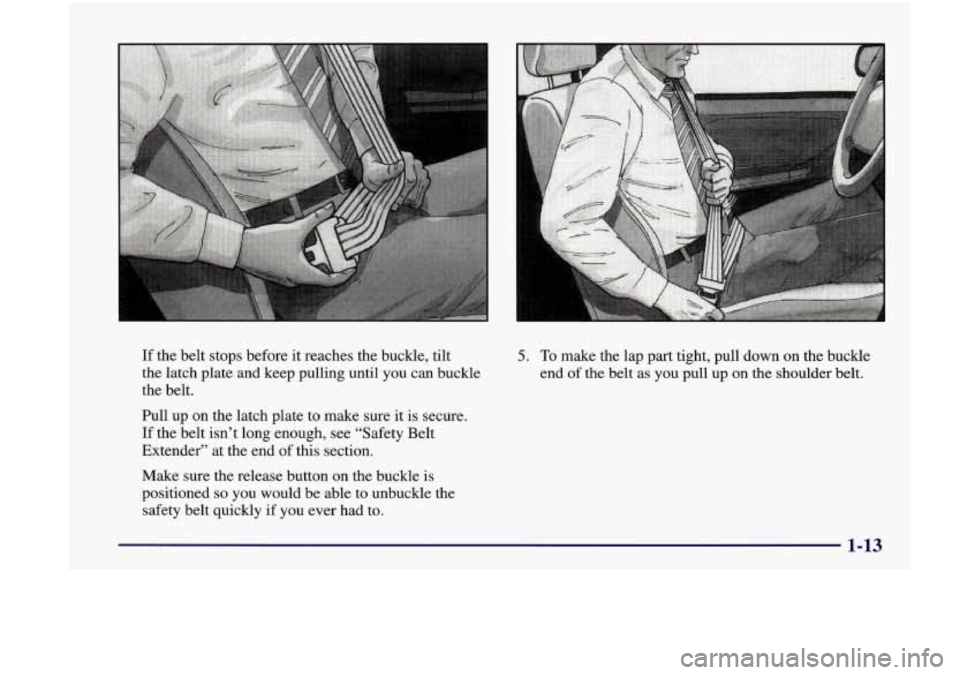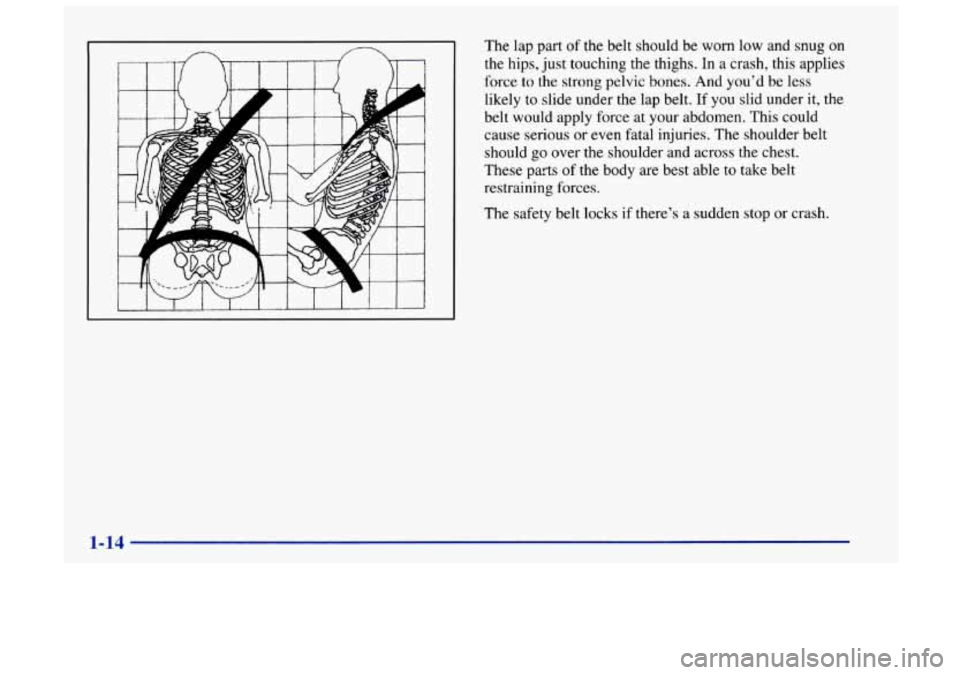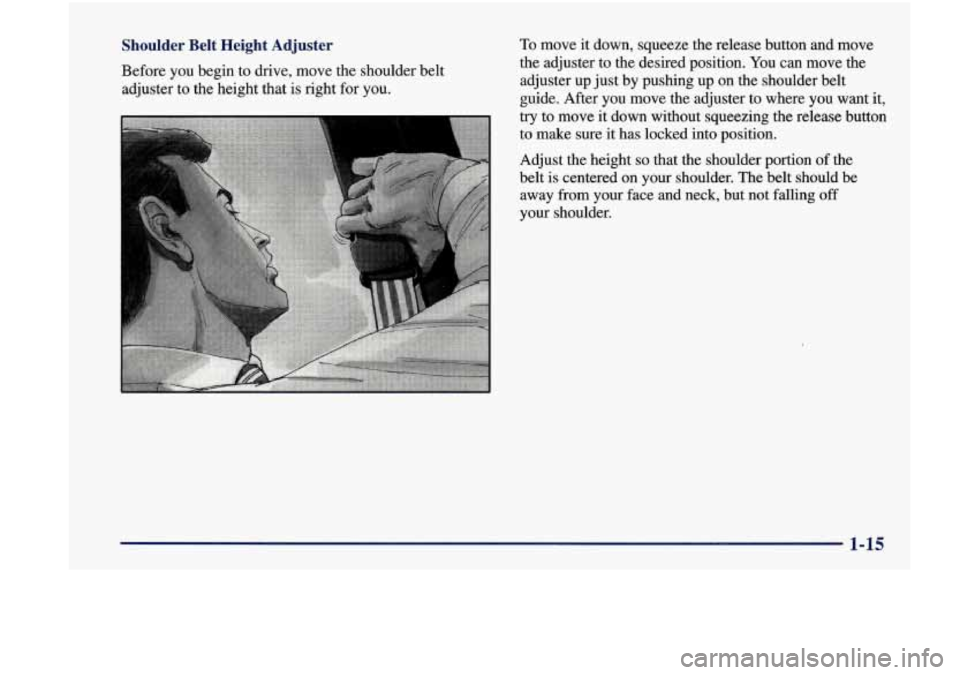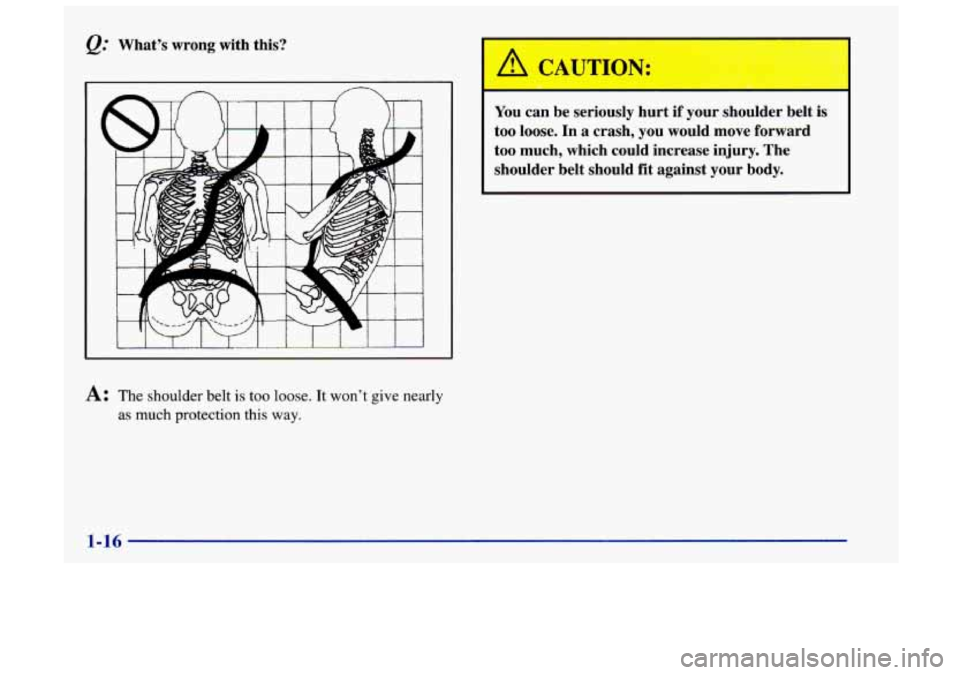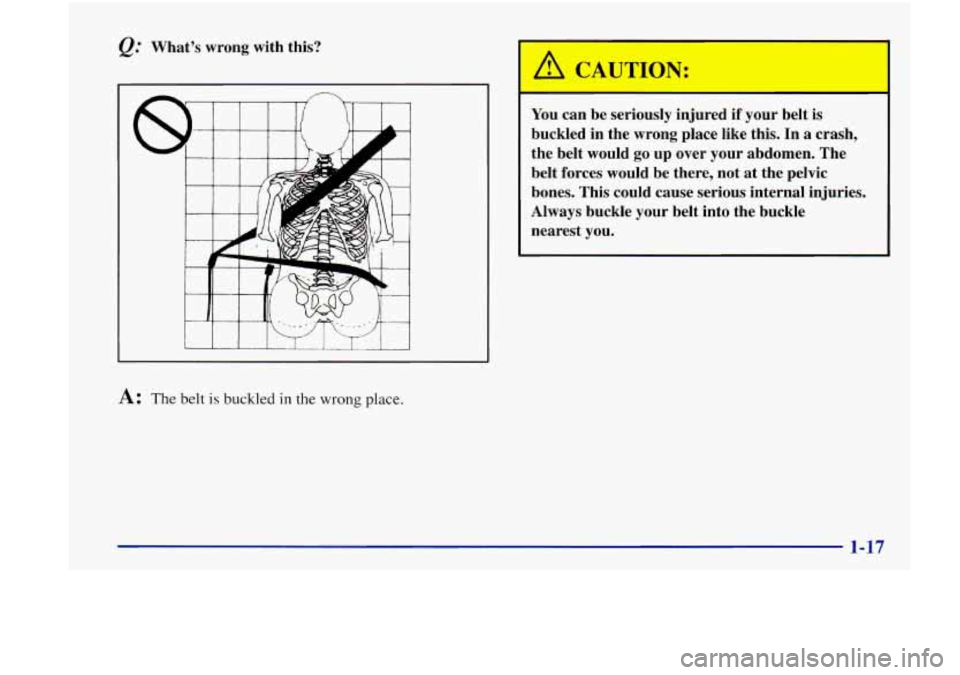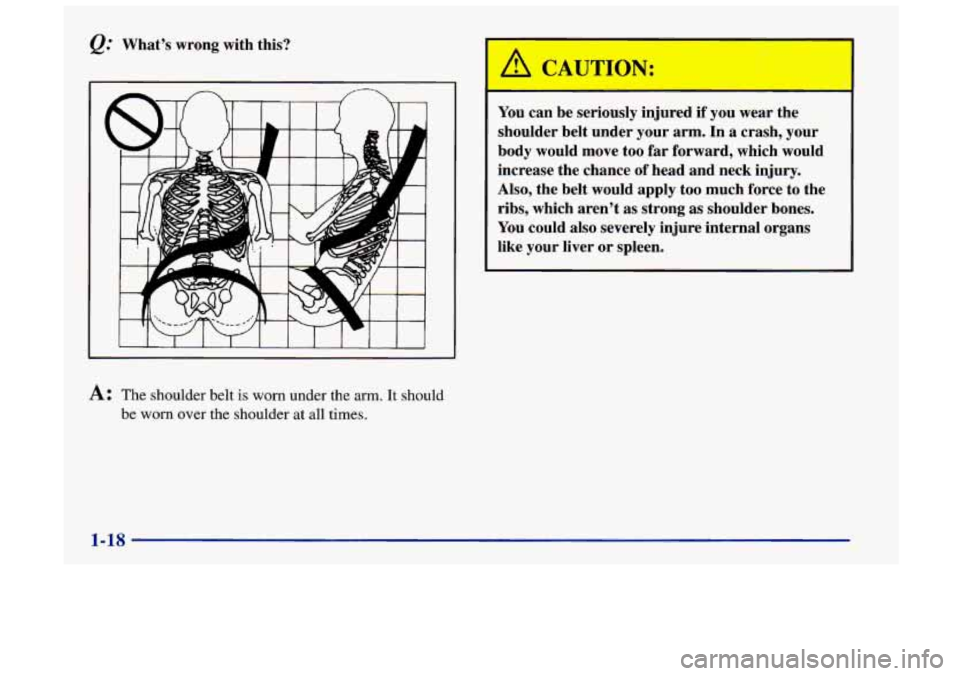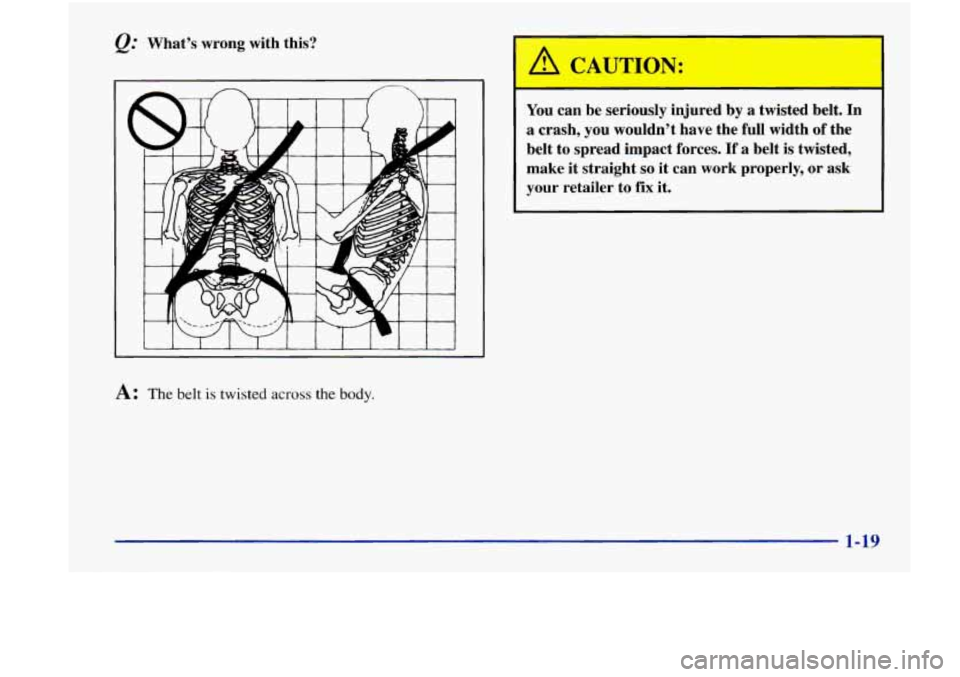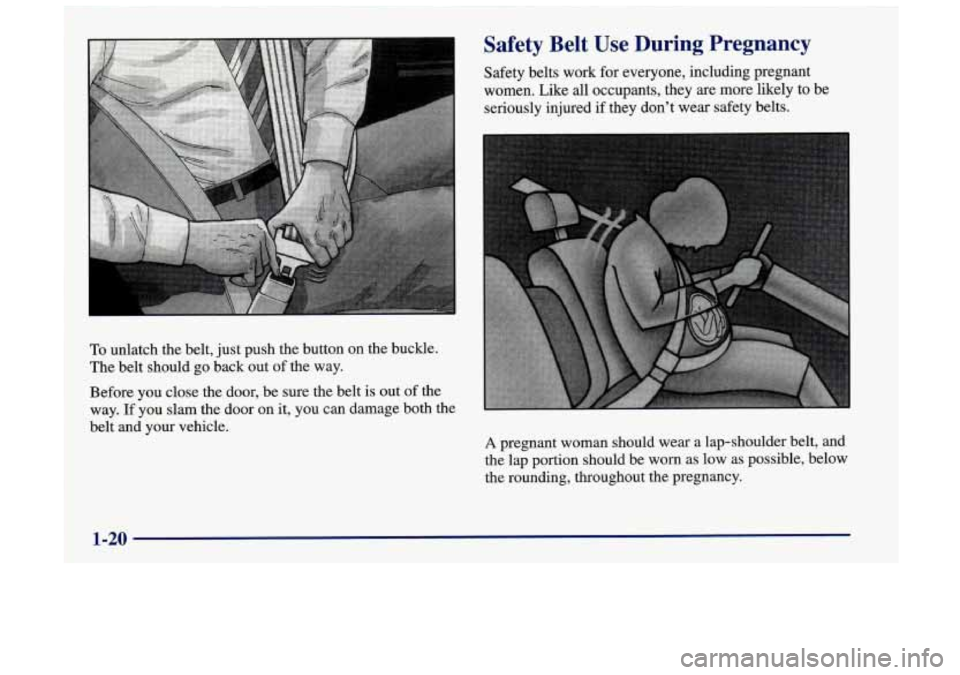Oldsmobile Achieva 1998 s Owner's Guide
Achieva 1998
Oldsmobile
Oldsmobile
https://www.carmanualsonline.info/img/31/9562/w960_9562-0.png
Oldsmobile Achieva 1998 s Owner's Guide
Trending: rear view mirror, weight, engine coolant, parking sensors, technical specifications, automatic transmission, wiper blades
Page 21 of 356
If the belt stops before it reaches the buckle, tilt
the latch plate and keep pulling until you can buckle
the belt. 5. To make the lap part tight, pull down on the buckle
end
of the belt as you pull up on the shoulder belt.
Pull up on the latch plate to make sure it is secure.
If the belt isn’t long enough, see “Safety Belt
Extender” at the end of this section.
Make sure the release button on the buckle is
positioned
so you would be able to unbuckle the
safety belt quickly if you ever had to.
1-13
Page 22 of 356
‘1 !A
The lap part of the belt should be worn low and snug on
the hips, just touching the thighs. In a crash, this applies
force
to the strong pelvic bones. And you’d be less
likely to slide under the lap belt.
If you slid under it, the
belt would apply force at your abdomen. This could
cause serious or even fatal injuries. The shoulder belt
should
go over the shoulder and across the chest.
These
parts of the body are best able to take belt
restraining forces.
The safety belt locks if there’s
a sudden stop or crash.
1-14
Page 23 of 356
Shoulder Belt Height Adjuster
Before you begin to drive, move the shoulder belt
adjuster to the height that
is right for you.
To move it down, squeeze the release button and move
the adjuster to the desired position. You can move the
adjuster up just by pushing up on the shoulder belt
guide. After you move the adjuster to where you want it,
try to move it down without squeezing the release button
to make sure
it has locked into position.
Adjust the height
so that the shoulder portion of the
belt is centered on your shoulder. The belt should be
away from your face and neck, but not falling
off
your shoulder.
1-15
Page 24 of 356
Q: What’s wrong with this?
I I I I i I I I I
A: The shoulder belt is too loose. It won’t give nearly
as much protection this way.
You can be seriously hurt if your shoulder belt is
too loose. In a crash, you
would move forward
too much, which could increase injury. The
shoulder belt should fit against your body.
Page 25 of 356
@ What's wrong with this?
A CAL JON:
A: The belt is buckled in the wrong place. You
can be seriously injured if your belt is
buckled in the wrong place like this. In
a crash,
the belt would
go up over your abdomen. The
belt forces would be there, not at the pelvic
bones. This could cause serious internal injuries.
Always buckle your belt into the buckle
nearest you.
Page 26 of 356
12: What's wrong with this?
'A
You can be seriously injured if you wear the
shoulder belt under your arm. In
a crash, your
body would move too far forward, which would
increase the chance of head and neck injury.
Also, the belt would apply too much force to the
ribs, which aren't
as strong as shoulder bones.
You could also severely injure internal organs
like your liver or spleen.
I
A: The shoulder belt is worn under the arm. It should
be
worn over the shoulder at all times.
1-18
Page 27 of 356
What's wrong with this?
A: The belt is twisted across the body.
1
You can be seriously injured by a twisted belt. In
a crash, you wouldn't have the full width of the
belt to spread impact forces.
If a belt is twisted,
make it straight
so it can work properly, or ask
your retailer to
fix it.
I
1-19
Page 28 of 356
Safety Belt Use During Pregnancy
Safety belts work for everyone, including pregnant
women. Like all occupants, they
are more likely to be
seriously injured
if they don’t wear safety belts.
To unlatch the belt, just push the button on the buckle.
The belt should go back out of the way.
Before you close the door, be sure the belt is out of the
way.
If you slam the door on it, you can damage both the
belt and your vehicle.
A pregnant woman should wear a lap-shoulder belt, and
the lap portion should be worn as low as possible, below
the rounding, throughout the pregnancy.
1-20
Page 29 of 356
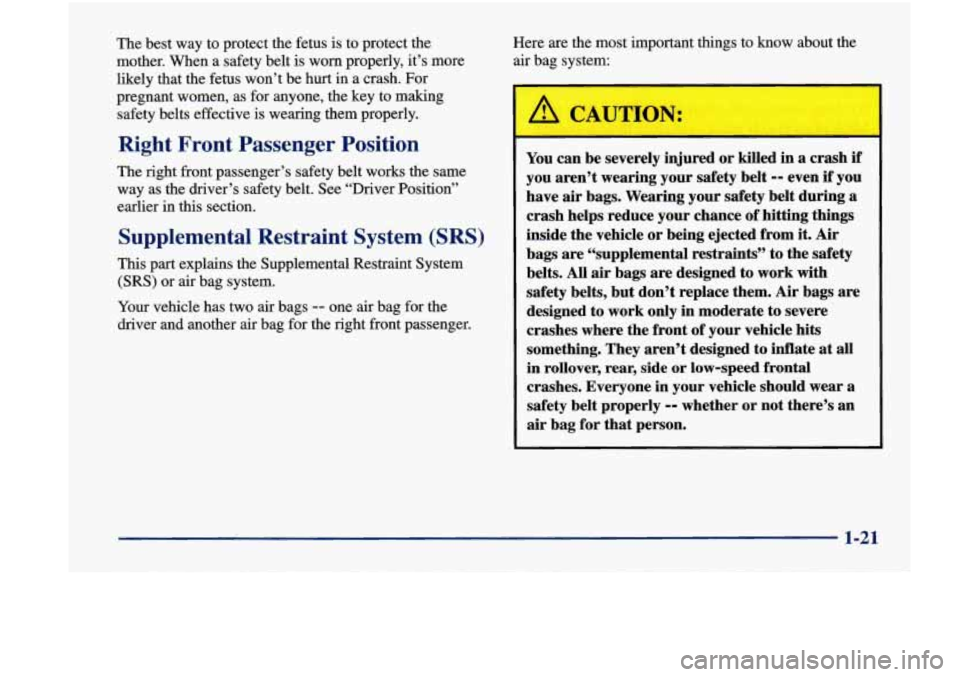
The best way to protect the fetus is to protect the
mother. When a safety belt is worn properly, it’s more
likely that the fetus won’t be hurt in a crash. For
pregnant women, as for anyone, the key to making
safety belts effective is wearing them properly.
Right Front Passenger Position
The right front passenger’s safety belt works the same
way as the driver’s safety belt. See “Driver Position’’
earlier in
this section.
Supplemental Restraint System (SRS)
This part explains the Supplemental Restraint System
(SRS) or air bag system.
Your vehicle
has two air bags -- one air bag for the
driver and another
air bag for the right front passenger. Here
are the most important things to know about the
air bag system:
You can be severely injured or killed in a crash if
you aren’t wearing your safety belt
-- even if you
have air bags. Wearing your safety belt during
a
crash helps reduce your chance of hitting things
inside the vehicle or being ejected from it. Air
bags are “supplemental restraints” to the safety
belts. All air bags are designed to work with
safety belts, but don’t replace them.
Air bags are
designed to work only in moderate to severe
crashes where the front of your vehicle hits
something. They aren’t designed to inflate at all
in rollover, rear, side
or low-speed frontal
crashes. Everyone in your vehicle should wear a
safety belt properly
-- whether or not there’s an
air bag for that person.
1-21
Page 30 of 356
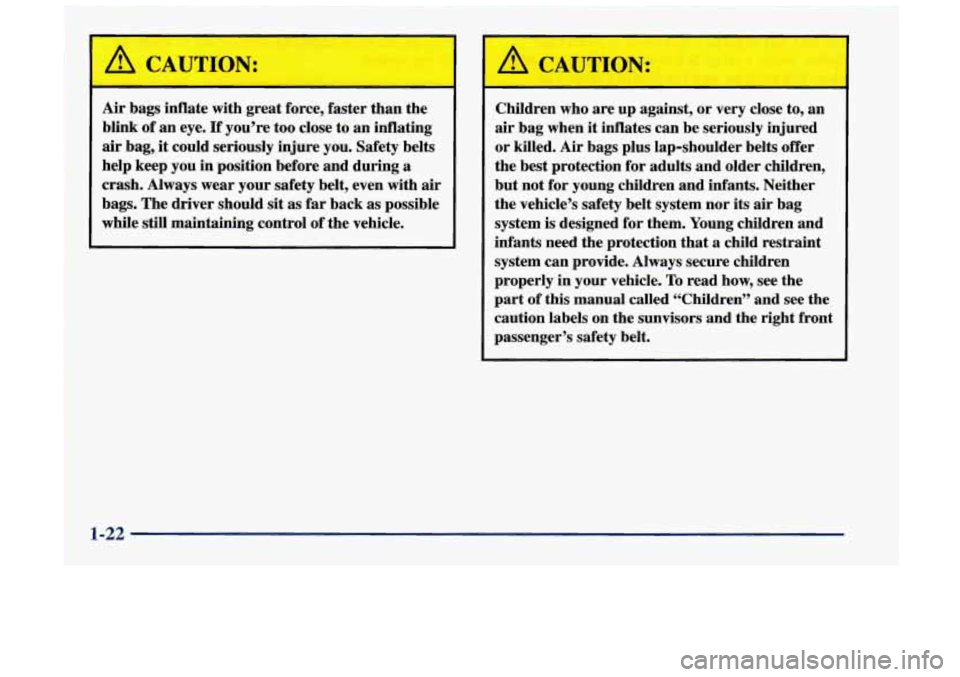
A CAUTION:
Air bags inflate with great force, faster than the
blink of an eye.
If you’re too close to an inflating
air bag, it could seriously injure you. Safety belts
help keep you in position before and during a
crash. Always wear your safety belt, even with air
bags. The driver should sit as far back as possible
while still maintaining control of the vehicle.
~
‘
A CAUTION:
Children who are up against, or very close to, an
air bag when it inflates can be seriously injured
or killed. Air bags plus lap-shoulder belts offer
the best protection for adults and older children,
but not for young children and infants. Neither
the vehicle’s safety belt system nor its air bag
system is designed for them. Young children and
infants need the protection that
a child restraint
system can provide. Always secure children
properly in your vehicle.
To read how, see the
part
of this manual called “Children” and see the
caution labels on the sunvisors and the right front
passenger’s safety belt.
1-22
Trending: oil type, height, heater, oil level, oil, oil dipstick, AUX
